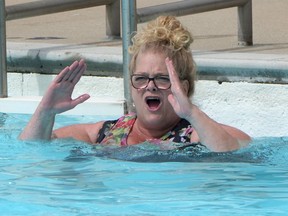Drowning Prevention Week

Article content
The mandate of the Lifesaving Society is to eradicate drowning.
That’s the goal year-round, and during Drowning Prevention Week the Society tries hard to make sure the message gets out.
“Every year we try to run some special (Lifesaving Society Drowning Prevention Week) activities at the Water Park,” said Julie Dawley, Aquatics Supervisor with the Town of Tillsonburg, and since April President of the Lifesaving Society Ontario. “This year with COVID-19, we’re not running all the activities like we would, but we are still making announcements – we’re talking about it.
“We want to eliminate drowning altogether, and we do that through many different ways – teaching kids how to swim, water safety education, first aid and lifeguard training. Even our lifesaving sport is an avenue for kids to compete in lifeguarding skills, but constantly creates water smart youth. There are so many different avenues aquatically that you can do through the Lifesaving Society.”
Statistically, nearly 400 people drown every year in Canada.
“That’s too many,” said Dawley, “when you can learn how to swim and prevent this from happening.”
Dawley noted those statistics are for people who died, not people who were rescued.
“You don’t hear about drownings where people are saved, the positive outcomes. And there is a lot. Drowning is more of a problem than we even think it is because it’s not investigated. So the Lifesaving Society is working on means of recording these… because I think it will highlight the need for more attention to this.”
Statistics show 77 per cent of the drowning victims were male. The highest percentage of death rates according to 2020 statistics are ages 20-34 (22%), ages 50-64 (25%) and ages 65-plus (27%). Twenty-eight per cent were aquatic related, 21% boating (half of those power boats), and 18% non-aquatic.
This year, with pools closed due to the COVID-19 pandemic, backyard pools have become even more popular. And sometimes parents are not as diligent as they should be.
“As a Society, that’s one of our concerns,” said Dawley. “Pools are hot commodities this summer, more than ever. So now we have more backyard pools with people who maybe, aren’t necessarily supervising their kids… and it happens all the time. We’ve talked extensively about this because we think it will be a bigger issue this year.
“The backyard pools, that’s the most common location for children under five to die. And drowning is the second leading cause of unintentional death among Canadian children under 10 years of age. The two highest risk groups right now are children under five and men 18-49.
“Tillsonburg has more stringent rules on backyard pools, which is a godsend in a way because you know there is proper fencing. A lot of the parents in our community do a great job of making sure their kids learn to swim. But it’s the judgment skills. There are some kids who we have taught through our program who are four, who can swim lengths. But they don’t have the judgment skills, at that age, that come with maturity. They make bad decisions sometimes. And that’s why it’s important that kids are within arm’s reach.
“The (mobile) phones are are a big thing now. We have posters right now from the Lifesaving Society that say ‘Watch me, not your phone.’ It shows a parent sitting by the pool, looking at their phone. And we all do it.”
Across Ontario this year, Dawley estimates 98 per cent of the kids who would have taken Swim to Survive lessons did not get those lessons this year, because of COVID. Children do not learn how to swim in three lessons, she said, but they learn water safety and basic skills, enough that if they fall in the water they will be able to survive it.
Swim to Survive also tries to instill in children a desire to learn to swim, she added.
NEW PROTOCOLS
In a COVID-19 pandemic, new protocols have been introduced for lifeguards.
“We are being looked at as an emergency professional,” said Dawley.
As an example, Dawley noted that prior to reopening Tillsonburg’s outdoor pool at the Lake Lisgar Water Park, lifeguard staff had to learn new skills, and the Town followed suggestions from the Lifesaving Society.
“We did an airway management course, so that we could move from doing mouth-to-mouth ventilation to doing bag valve mask. Just to add that extra layer of protection for them.
“Now, we can even administer oxygen. So it’s a whole new level of care actually, which is exciting.”
Swimmers are screened before entering the pool area, but there is an unknown factor. Some people do not know they are COVID-19 carriers.
“That’s why we added this extra level of protection. I think most pools in Ontario will be moving toward a bag valve mask system, just to ensure the safety of the patients and for us. Most first aid courses, they are saying there’s no ventilations, it’s just CPR-only unless you have a proper mask that has a filter, or BVM (bag valve mask).
“We have them now in Tillsonburg, for adults and children. You’ll be well taken care of if something happens.”
Postmedia is committed to maintaining a lively but civil forum for discussion. Please keep comments relevant and respectful. Comments may take up to an hour to appear on the site. You will receive an email if there is a reply to your comment, an update to a thread you follow or if a user you follow comments. Visit our Community Guidelines for more information.